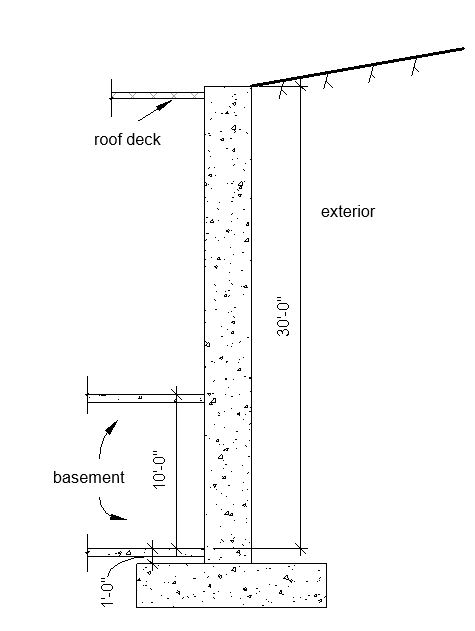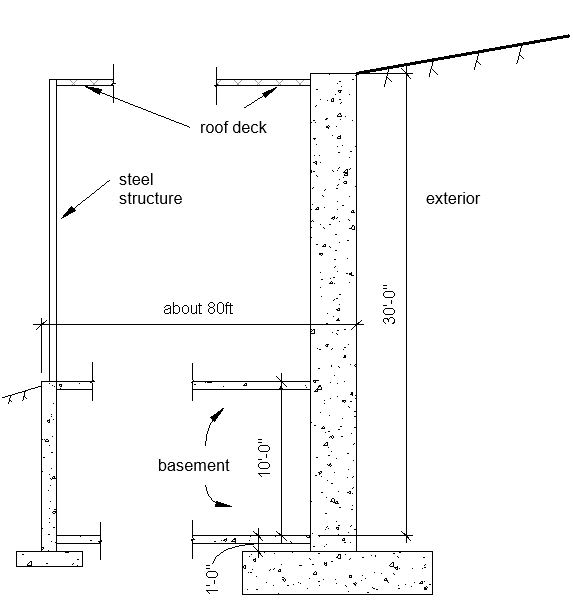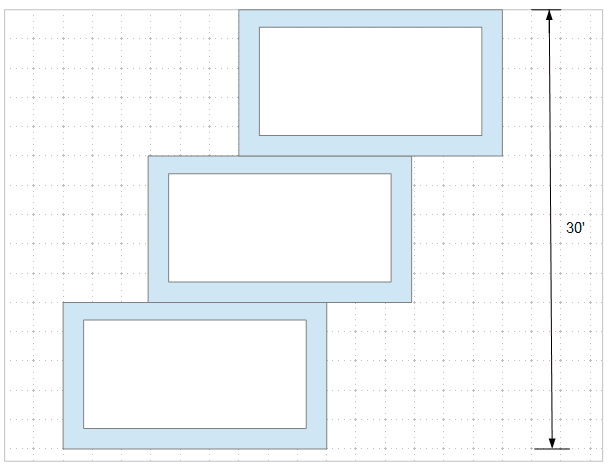Hello, I need some suggestions on a 30 ft high retaining wall. I never designed a retaining wall more than 9ft high. The wall is also part of the building, and we do not want to transfer the load to the building. I attached a preliminary geometry. Please take a look to see it makes sense and let me know your suggestions and anything I need to consider. Thanks very much!
Navigation
Install the app
How to install the app on iOS
Follow along with the video below to see how to install our site as a web app on your home screen.
Note: This feature may not be available in some browsers.
More options
Style variation
-
Congratulations cowski on being selected by the Eng-Tips community for having the most helpful posts in the forums last week. Way to Go!
You are using an out of date browser. It may not display this or other websites correctly.
You should upgrade or use an alternative browser.
You should upgrade or use an alternative browser.
30 ft high retaining wall 3
- Thread starter Engin1
- Start date
- Status
- Not open for further replies.
- Thread starter
- #21
I don't understand why you're considering this as a cantilever retaining wall? to me, the slabs at the basement and main floor level provide lateral support to the wall, same for the roof deck. That loading needs to go somewhere obviously but the side walls should provide the level of shear wall in that direction required provided the diaphragms at each floor level have the capacity to transfer the backfill loads to the side walls.
It is really tough to give suggestions without knowing all the contraints and dimensions. What does the plan look like? Is this an addition or is all of the construction new?
It is really tough to give suggestions without knowing all the contraints and dimensions. What does the plan look like? Is this an addition or is all of the construction new?
- Thread starter
- #25
JoshPlumSE
Structural
If this is new construction, have you ever considered a "secant pile wall"? I came across one on a project in the 1990's. I got the sense that it saved a lot of time and money due to the deep excavation that would have otherwise been required for the basement walls.
With a 30 ft excavation on one side, and the large thickness required for this wall, it seems to me that a secant pile wall may be a more efficient way to go.
With a 30 ft excavation on one side, and the large thickness required for this wall, it seems to me that a secant pile wall may be a more efficient way to go.
Engin1,
Thank you. I would expect that the basement walls and Main Floor slab will have a significant effect on the performance of the retaining wall. The differential height of soil is 20', still a very high retaining wall, assuming no shear walls occurring above Main Floor.
BA
Thank you. I would expect that the basement walls and Main Floor slab will have a significant effect on the performance of the retaining wall. The differential height of soil is 20', still a very high retaining wall, assuming no shear walls occurring above Main Floor.
BA
As it's shown you really don't have a choice but to include the lateral earth pressure in your building lateral system analysis and design.
Based on your sketch it looks like grade may continue to taper off on the low side, if it hasn't been done already I'd strongly encourage the Geotech to do a global site slope stability analysis as if this doesn't check out it won't matter if the retaining wall design works or not. I'd also be very careful of global sliding in this case.
My Personal Open Source Structural Applications:
Open Source Structural GitHub Group:
Based on your sketch it looks like grade may continue to taper off on the low side, if it hasn't been done already I'd strongly encourage the Geotech to do a global site slope stability analysis as if this doesn't check out it won't matter if the retaining wall design works or not. I'd also be very careful of global sliding in this case.
My Personal Open Source Structural Applications:
Open Source Structural GitHub Group:
Scant and tangent wall are viable solutions for deep excavation like this. But I would suggest to look into "slurry wall", or diaphragm wall, which can be utilized as part of the building, after the slurry is replaced by termite concrete. Link
- Thread starter
- #30
JoshPlumSE,
I haven't used secant pile wall. thanks for your info, I need to do some research on "secant pile wall".
BAretired, Yes the main floor does have a significant effect. 20' is still a lot. The retaining wall is 30ft long, and at the end it will have perpendicular walls which can resist some shear forces.
I haven't used secant pile wall. thanks for your info, I need to do some research on "secant pile wall".
BAretired, Yes the main floor does have a significant effect. 20' is still a lot. The retaining wall is 30ft long, and at the end it will have perpendicular walls which can resist some shear forces.
If the new wall is a tiedback wall, it too should be isolated from the building to prevent differential movement and structure damage. There should be some type of expansion joint to allow the wall and the building to move independently.
structSU10
Structural
An open cut to put in the retaining wall is the problem, and a type of wall that is installed as you dig out for the building makes a lot more sense.
Can soil nail walls be installed as you cut down? I am unsure, but I could see a soil nail wall making sense, with a permanent cast in place facing that is used for the finished building face.
Can soil nail walls be installed as you cut down? I am unsure, but I could see a soil nail wall making sense, with a permanent cast in place facing that is used for the finished building face.
To me this isn't a retaining wall in the regular sense of the word. Based on that section, it is a building wall, retaining soil. There is almost zero likelihood that the building would be removed but that wall would remain standing since the building frames into the wall. Design each diaphragm for the forces it will see, give them a load path to the ground, and then all you are doing is designing a 20ft tall wall with soil pressure, and a 10ft wall with soil pressure, or a continuous uneven two-span wall with soil pressure if you would prefer. Either way, I would not be designing this as a 30ft tall cantilevered (or tied back) retaining wall that must stand alone.
Really without a full plan view indicating the length of this wall between potential support (shear) walls, we can't know for sure what are possible solutions.
Really without a full plan view indicating the length of this wall between potential support (shear) walls, we can't know for sure what are possible solutions.
If the wall is only 30' long with a support at each end, it makes economic sense to connect the retaining wall to the building, using building elements to resist the soil pressure. Removal of the building may be a concern a long time in the future.
The use of tiebacks may be a consideration if the adjacent property belongs to the building owner, but tying into a neighbour's property may be asking for trouble in the future.
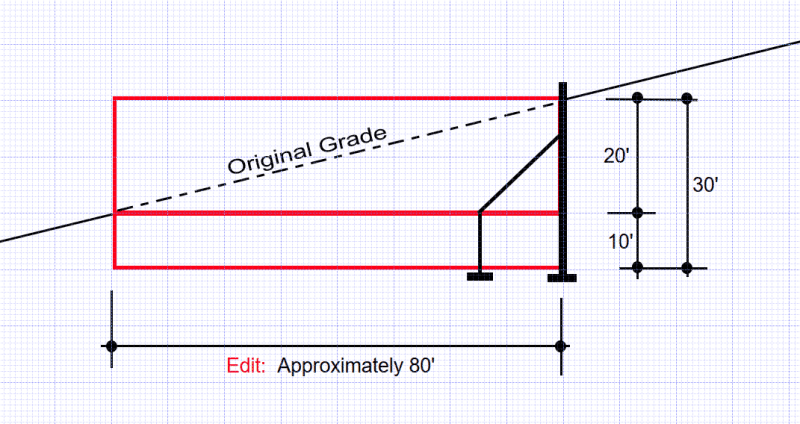
BA
The use of tiebacks may be a consideration if the adjacent property belongs to the building owner, but tying into a neighbour's property may be asking for trouble in the future.

BA
- Thread starter
- #35
Thank everyone for your suggestions. Our senior engineer suggested to use soil nails to reduce the wall thickness and footing sizes. First, I am going to try using the building to resist the soil pressure first and see if it works out. And I will also try the tie back method using soil nails or other kinds ties. thanks!
I wanted to comment on your post earlier but didn't get a chance. Perhaps I missed it earlier but is this a cut or fill condition? That completely governs my stance on the design approach you should take.
If in a cut condition, I liked the idea of the soil nails only if the wall is not carrying any vertical loads from the building. Soil nail walls resist lateral loads very well but should not be used to carry vertical loads.
A cast-in-place final facing for the soil nail wall is probably the nicest finish and most durable but also will have some expensive forming costs. This is a tall one-sided form. I have been a part of some soil nail projects where we formed the outside CIP facing by drilling and epoxying GFRP dowels 4" into the face of the initial shotcrete layer and tying those into the formwork walers. I was sweating a bit when they were pouring the concrete as I knew a failure would have meant dumping about 50 yards of concrete right into some pristine ocean shoreline but it worked. Most Contractors are going to look at that one-sided form and automatically assume that they will have to shore and buttress it from one side which will be costly for a 30ft tall wall.
If in a cut condition, I liked the idea of the soil nails only if the wall is not carrying any vertical loads from the building. Soil nail walls resist lateral loads very well but should not be used to carry vertical loads.
A cast-in-place final facing for the soil nail wall is probably the nicest finish and most durable but also will have some expensive forming costs. This is a tall one-sided form. I have been a part of some soil nail projects where we formed the outside CIP facing by drilling and epoxying GFRP dowels 4" into the face of the initial shotcrete layer and tying those into the formwork walers. I was sweating a bit when they were pouring the concrete as I knew a failure would have meant dumping about 50 yards of concrete right into some pristine ocean shoreline but it worked. Most Contractors are going to look at that one-sided form and automatically assume that they will have to shore and buttress it from one side which will be costly for a 30ft tall wall.
HTURKAK
Structural
- Jul 22, 2017
- 3,352
I will not recommend the use of soil nailing for permanent use adjacent to human occupied building. The building service life could be more than 50 years while soil nailing could be in the range of 30 years. Another issue, if the adjacent area where soil nailing will extent is a private area, they may excavate and disturb the nailing .
I will suggest to change the perimeter columns to walls similar to buttresses ( in this case,e.g. b= 16 in h= 80 in ) and the wall thick . could be 16 in. Another option, provide setback and construct semi gravity or cantilever retaining wall so the building structure will get free .
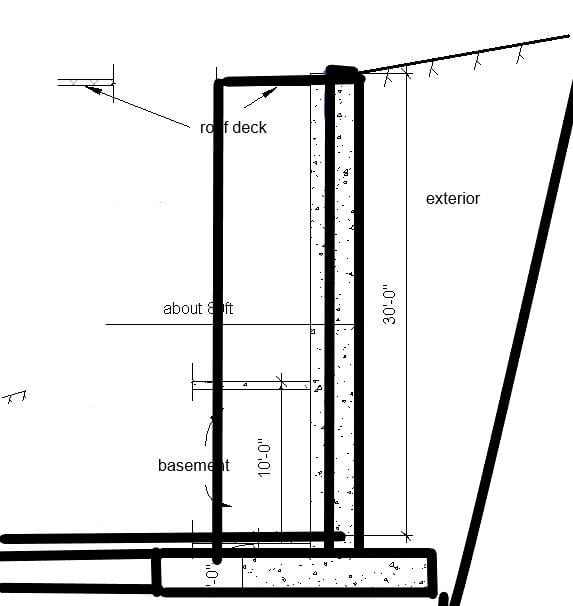
- Thread starter
- #38
HTURKAK, can you please give a reference for the 30 year life of a soil nail wall? That would be unwelcome news to US highway departments which insist on much more than a 30 year wall life.
- Status
- Not open for further replies.
Similar threads
- Replies
- 4
- Views
- 8K
- Replies
- 32
- Views
- 30K
- Question
- Replies
- 10
- Views
- 9K
- Replies
- 15
- Views
- 13K
- Replies
- 6
- Views
- 3K

